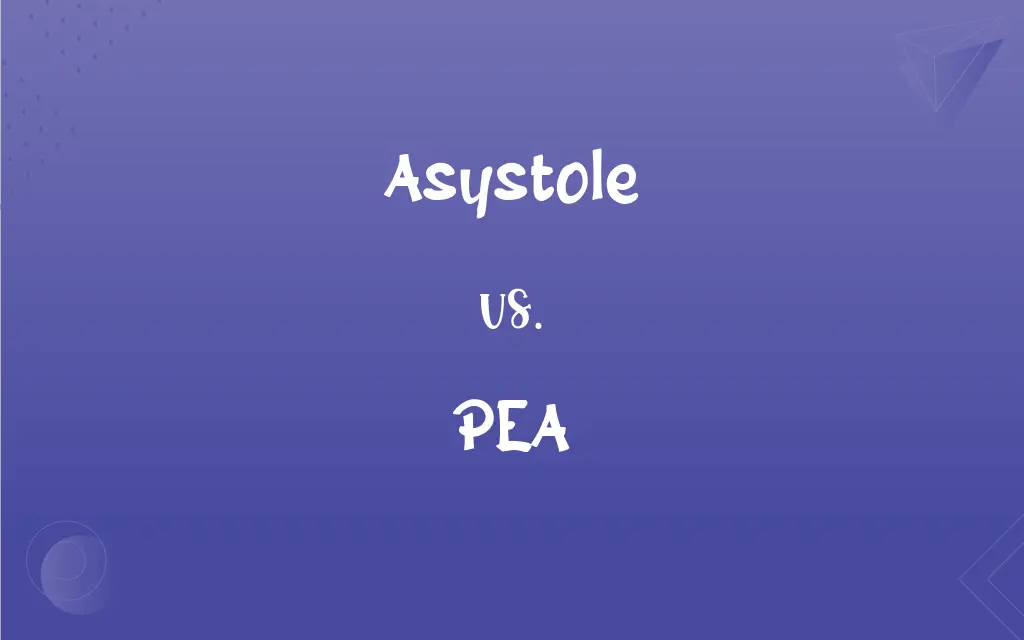Asystole vs. PEA: What's the Difference?
Edited by Aimie Carlson || By Janet White || Published on February 29, 2024
Asystole is a flatline ECG with no electrical activity; PEA is a normal ECG but without a pulse due to mechanical problems in the heart.

Key Differences
Asystole is a cardiac arrest rhythm characterized by a flatline on an electrocardiogram (ECG), indicating no electrical activity in the heart. Conversely, Pulseless Electrical Activity (PEA) presents with organized electrical activity on the ECG but without a detectable pulse, due to inadequate cardiac mechanical function.
The causes of asystole include severe hypoxia, acidosis, or prolonged cardiac arrest. PEA, on the other hand, can result from various conditions such as hypovolemia, hypoxia, hydrogen ion (acidosis), hypo-/hyperkalemia, hypothermia, tension pneumothorax, cardiac tamponade, thrombosis (coronary or pulmonary), and toxins.
Treatment of asystole involves immediate cardiopulmonary resuscitation (CPR) and administration of epinephrine. In the case of PEA, the treatment also includes CPR but focuses more on correcting the underlying cause, following the H's and T's approach (Hypovolemia, Hypoxia, Hydrogen ion, Hypo-/Hyperkalemia, Hypothermia, Tension pneumothorax, Tamponade, Thrombosis, Toxins).
Asystole generally has a poorer prognosis compared to PEA, as it indicates a complete cessation of electrical activity in the heart. PEA may have a slightly better prognosis as there is some remaining cardiac electrical activity, which might be restored with appropriate treatment.
Diagnosing asystole requires careful interpretation of ECG to confirm the absence of electrical activity, ruling out fine ventricular fibrillation. PEA diagnosis is also ECG-dependent but requires clinical correlation to confirm the absence of a pulse despite electrical activity.
ADVERTISEMENT
Comparison Chart
ECG Reading
Flatline, no electrical activity
Normal or near-normal, but no pulse
Underlying Cause
Often irreversible causes like prolonged cardiac arrest
Reversible causes like hypovolemia, toxins
Treatment Focus
CPR, epinephrine
CPR, correct underlying cause
Prognosis
Generally poor
Potentially better if cause is corrected
Clinical Significance
Indicates end-stage cardiac arrest
Indicates a problem in cardiac mechanical function despite electrical activity
ADVERTISEMENT
Asystole and PEA Definitions
Asystole
Asystole is a state of no cardiac electrical activity, as seen in a flat ECG.
The patient's ECG showed asystole, indicating a dire need for resuscitative efforts.
PEA
A pea is a small spherical seed or seed-pod of the legume Pisum sativum.
She added fresh peas to the soup for extra flavor.
Asystole
Asystole is an unshockable rhythm, meaning defibrillation is not effective.
The defibrillator was not used as the patient was in asystole.
PEA
Peas are a source of plant-based protein and fiber.
For a healthy diet, he included peas in his meals for their protein content.
Asystole
Asystole represents the final phase in the cardiac arrest spectrum.
Despite all efforts, the patient's condition deteriorated into asystole.
PEA
Peas are used in a variety of dishes, from soups to salads.
The recipe called for a cup of frozen peas.
Asystole
Asystole often indicates cardiac death if not rapidly reversed.
The asystole on the monitor confirmed the worst fears of the medical team.
PEA
Peas are cultivated as a cool-season vegetable crop.
Her spring garden was dedicated to growing sweet peas.
Asystole
Asystole is a non-viable heart rhythm with no pulse generation.
Emergency services declared asystole, showing no hope for cardiac activity.
PEA
Peas are commonly green and encased in a pod.
The garden was full of green pea pods ready to be harvested.
Asystole
Absence of systole; failure of the heart to contract.
PEA
A member of the pea family.
Asystole
A weakening or cessation of the contractile power of the heart.
PEA
A widely cultivated climbing annual vine (Pisum sativum) native to Eurasia, having compound leaves with terminal leaflets modified into tendrils and globose, edible seeds enclosed in a green, elongated pod.
Asystole
Absence of systole; failure of the ventricles of the heart to contract (usually caused by ventricular fibrillation) with consequent absence of the heart beat leading to oxygen lack and eventually to death
FAQs
Can asystole be treated?
Asystole is treated with CPR and sometimes epinephrine, but chances of recovery are low.
Can you defibrillate asystole?
No, defibrillation is not effective in asystole as there is no electrical activity to reset.
How is asystole different from a heart attack?
Asystole is a cardiac arrest rhythm with no heart activity, while a heart attack (myocardial infarction) is caused by blocked blood flow to the heart.
Is asystole the same as flatline?
Yes, asystole is commonly known as a flatline, indicated by a flat line on an electrocardiogram (ECG).
What causes asystole?
Causes include severe heart disease, prolonged cardiac arrest, drug overdose, and extreme hypoxia.
Is asystole painful?
Asystole itself is not painful as it causes loss of consciousness due to lack of blood flow.
How is asystole diagnosed?
Asystole is diagnosed using an ECG, which shows a flatline, indicating no heart activity.
What nutrients are in peas?
Peas contain protein, fiber, vitamins A, C, K, and B vitamins, and minerals like iron and manganese.
What is asystole?
Asystole is a state of no cardiac electrical activity, leading to no contractions of the heart and no blood flow.
What is the prognosis for asystole?
Prognosis is generally poor, as it often indicates a severe underlying condition.
Are peas legumes?
Yes, peas are legumes, belonging to the family Fabaceae.
Can peas be eaten raw?
Yes, young, tender peas can be eaten raw and are often sweet.
Are frozen peas as nutritious as fresh peas?
Yes, frozen peas retain most of their nutrients and are a good alternative to fresh peas.
Can asystole be prevented?
Prevention includes managing heart disease risk factors and avoiding drug overdoses.
Can peas be grown at home?
Yes, peas can be easily grown in gardens or pots, requiring cool weather and support for climbing.
What is the difference between green peas and chickpeas?
Green peas are small and round, while chickpeas are larger, firmer, and used in different cuisines.
Are peas good for weight loss?
Peas are low in calories and high in fiber, making them a good choice for weight loss diets.
Can people with diabetes eat peas?
Yes, in moderation, as peas have a low glycemic index and are high in fiber.
What is a pea?
A pea is a small, round, green vegetable, typically grown in pods.
How are peas typically cooked?
Peas can be boiled, steamed, stir-fried, or added to soups and stews.
About Author
Written by
Janet WhiteJanet White has been an esteemed writer and blogger for Difference Wiki. Holding a Master's degree in Science and Medical Journalism from the prestigious Boston University, she has consistently demonstrated her expertise and passion for her field. When she's not immersed in her work, Janet relishes her time exercising, delving into a good book, and cherishing moments with friends and family.
Edited by
Aimie CarlsonAimie Carlson, holding a master's degree in English literature, is a fervent English language enthusiast. She lends her writing talents to Difference Wiki, a prominent website that specializes in comparisons, offering readers insightful analyses that both captivate and inform.






































































